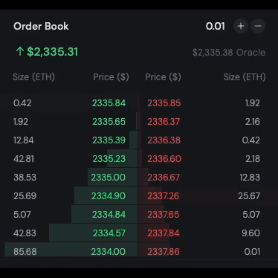Bluefin Relies on Sui Performance For First Class DeFi
Sui's network performance and user onboarding features helped Bluefin's DeFi platform log billions in volume.

Bluefin's founders wanted to offer advanced, capitally efficient derivatives trading on a decentralized platform competitive with anything in the traditional finance sector. The platform would need to be performant, inexpensive, and accessible to serve both institutional and individual users.
A beta launch in 2023 on Arbitrum, a layer 2 network built on Ethereum, helped the Bluefin team see the potential of its DeFi vision and gain a better understanding of the technology. The Bluefin Classic platform gained users who traded over $2.1 Billion over the course of the year. However, the team recognized limits to what it could accomplish on Arbitrum.
Exploring options, Bluefin found that Sui could not only meet its technical performance requirements, but also deliver a user experience unlike any other in the blockchain industry. In addition, Sui's transaction processing fees would be a fraction of those on other blockchains.
"From the start, we wanted to put user experience first for both institutional and retail users within decentralized finance, something we saw lacking in the industry and a great opportunity," said Bluefin co-founder Rabeel Jawaid.
With its next iteration, Bluefin v2, the company developed and launched a platform on Sui offering exceptionally quick trades and a seamless account creation process. Despite a launch in the last quarter of 2023, Bluefin v2 logged over $3.2 billion in trading volume in December alone, with over 80 percent market share in the ecosystem.
Derivatives demand
Among the many DeFi services available, Bluefin sees derivatives trading as the largest use case for crypto. Unlike a direct swap, derivatives traders agree to purchase a specific cryptocurrency amount at a set price sometime in the future, essentially making a bet on whether the token will increase or decrease in value.
Traders may enter into a set contract or pay for an option to buy the token at a specific price. With the former, a trader would gain value if the token increased in value. Under an option agreement, the trader can decline to purchase the token if its value decreased below the set option price.
Perpetual contracts, a recent addition at Bluefin, let traders enter a contract to buy a cryptocurrency at a set price with no specific end date. In these contracts, a trader who expects an increase in value, called going long, would want to sell when the token rises above their purchase price. Other traders may buy into a perpetual contract with an expectation the token will lose value, called going short. Each side of this trading equation pays a funding rate to maintain their position.
Milliseconds matter
Derivatives trading became popular in cryptocurrency markets due to users being able to go long and short, take on leverage, and deploy their capital more efficiently, such as using the same collateral to go long on Bitcoin and short on Ethereum. They are also significantly more liquid and have cheaper fees on most exchanges. However, only recently have blockchains offered the performance to support derivatives.
"Derivatives trading in DeFi requires high-performance blockchains and no decentralized protocol has yet matched the success of a leading centralized exchange because of the user experience challenges with onchain trading," said Rabeel. "We’re going to change that, and Sui enables us to do so."
Bluefin found that Sui meets its performance needs in two key metrics: transactions per second (TPS) and trade confirmation timing. Where TPS on other chains becomes a bottleneck during high volume trading, Sui handled 5,414 TPS in 2023 without hitting its theoretical or practical limit. Equally as important, Bluefin can give an optimistic confirmation of transactions in 30 milliseconds and finalize transactions in about 550 milliseconds. Each of these metrics meets the expectations of traditional finance platform users.

Letting traders conclude transactions in a timely manner is just half the battle. "A major step towards achieving scale on Bluefin is the elimination of the need for wallets," said Rabeel, "which aligns with our goal of emulating a Web2 trading experience while retaining the decentralization benefits of an on-chain protocol."
Bluefin leveraged Sui's zkLogin primitive to seamlessly bring new DeFi users onboard. Although existing DeFi users can begin trading on Bluefin by connecting a wallet, the platform gives people the option of creating an account through their Google or Apple login credentials. As a primitive on Sui, zkLogin does not depend on a middleman, which would increase costs and create a security risk. zkLogin uses zero-knowledge proofs to verify a user's identity without requiring Bluefin to store IDs or passwords.
As the icing on Bluefin's DeFi cake, Sui's consistently low transaction fees further served its users. As an axiom similar to buy low, sell high, traders seek the lowest fees for their activities, as fees eat into capital that could be put to better use. Transaction fees on Bluefin v2 are coming in at below $0.005 per trade. Arbitrum's base fee comes in at 1 GWEI, equivalent to $0.005, and rises with network demand, penalizing users as transactions increase. Sui's scalable architecture means that these fees do not rise as traffic increases, supporting Bluefin's high volume users.
Future forward
Although Bluefin v2 showed stellar performance in its short existence, the company plans to make it even better. Currently, it uses shared objects on Sui, which require consensus to achieve finality. Bluefin is redesigning its architecture so that all trades between parties will use owned objects in a trusted transaction, bypassing consensus to resolve as quickly as possible.
"We’ve benchmarked these trades to take about 400 milliseconds onchain to finalize," said Rabeel, "and coupled with a redesign of our offchain orderbook to intelligently partition trade submissions by users, we expect to reach up to 30,000 parallel trades per second of unique users before experiencing any delays in execution."
Beyond infrastructure updates, Bluefin wants to make its user experience even better. "Within the next few weeks, users will be able to land on our exchange, use Google to create an account, walk through a bridge to deposit funds, and start trading seamlessly," said Rabeel.
Future offerings will include the exchange's BLUE token and access to spot markets through DeepBook, Sui's first native liquidity layer. With such a strong start in late 2023, Bluefin's path looks bright in 2024.



